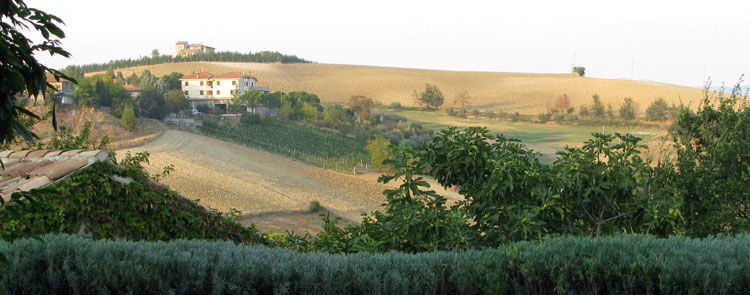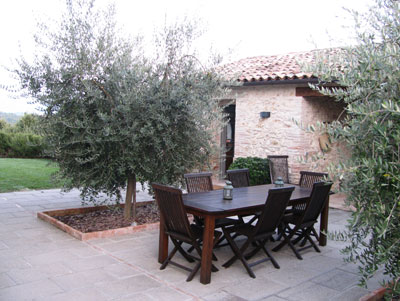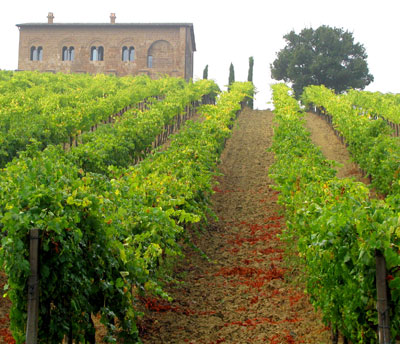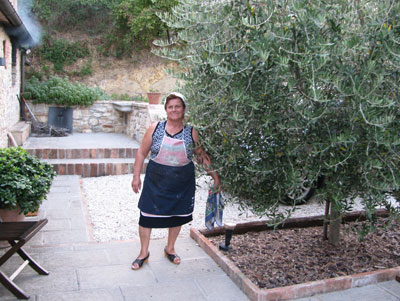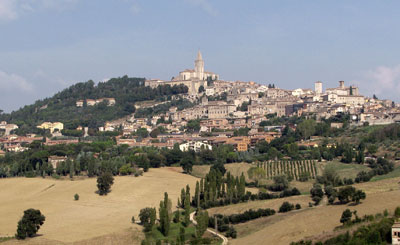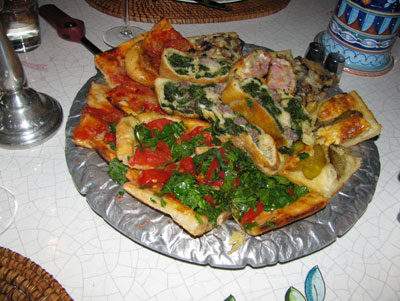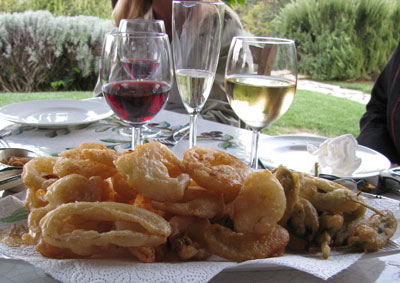Discovering ‘la dolce vita’ in Italy’s Umbria region
by Inga Aksamit, San Rafel, CA
As the lengthening shadows crept up the ocher hill, a slight breeze drifted through the open windows of the stone farmhouse carrying the scent of lavender and rosemary. An iron door creaked open followed by the sound of wood snapping and crackling.
Drawn to the window, I observed Dina deftly whipping the fire into a blazing inferno within moments, suddenly snapping the oven door shut to seal in the flames. I shivered in anticipation of the mouthwatering meal that would be forthcoming: the crisp crust of the pizza carrying the fresh flavors of garden herbs and tomatoes picked that morning, the delectable bounty from the countryside on its back.
A highlight of our September ’09 trip to Umbria — a hilly, rural region of Italy located between Rome and Florence — was the sampling of the local comestibles and fine wines.
Regional food
Six friends gathered from around the world to experiment with the many superior house wines (and remarkably few duds) typically available in the small cafés and dining establishments of the area’s various hill towns, washing down many fine, rustic meals produced from locally sourced ingredients.
Our tiny vehicle (rented from Hertz at a cost of $500 for one week) wound up hills and down valleys on narrow roadways, navigating by the hilltops studded with distinctive ancient castles, each unique in shape and character. Returning home each day laden with cured meats, cheeses, wines and pastries, we delighted in developing an appreciation for all flavors Umbrian.
The Slow Food movement is here without the label. The menus tend to use similar ingredients and do not feature exotic dishes from around the world. Instead, chefs utilize local produce, game and, best of all, an abundance of earthy truffles, gracing everything from pizza to pasta. Every country residence seemed to have a small grove of olive trees, resulting in rich, tawny olive oil. Grape vines surrounded the groves of olive trees, and familial wine barrels were common.
Fondo Le Teglie
Our base was the lovely Fondo Le Teglie (phone, from the US, 404/345-2603 or, in Italy, 39 074 494 5062, www.ilgustodelpaese.com), a 17th-century stone farmhouse and stable lovingly reconstructed into a warm, comfortable and modern house.
Located near the castle-topped hamlet of Sismano, the main house offered four large bedrooms plus a living room, dining room, family room and den, providing plenty of space for our group to spread out and relax on “down” days or gather together to dine and socialize. A spacious and well-stocked kitchen, complete with a double oven, provided the perfect foundation for cooking or, better yet, hiring Dina, a local cook, to cook for us.
There were several spaces available for alfresco dining or lounging, including a lovely pool overlooking the Umbrian hills, dotted with vineyards, olive orchards and massive fields of sunflowers.
The summer rate for the house, which sleeps eight to 10, is €4,000 ($5,120) per week.
Our hostess, American-born Susan, owner and operator of Fondo Le Teglie, breezed in and out between business trips to offer suggestions, make arrangements for activities and supply tips about the surrounding area. When Susan was in town, she stayed in the adjacent self-contained, one-bedroom apartment (wheelchair accessible), the Annex, which is also available for rental with advance notice (€1,200 per week).
She stocked the “big house” with an assortment of local wines, which we noted on a checklist as we consumed them so we could settle up at the end of our stay. This gave us our first taste of the wines of the area, educating our palates and readying us to learn more.
Dina’s delectable delights
On our first night in Umbria we met Dina. Susan had arranged for her to cook for us that night ($25 per person).
A formidable woman of short stature, Dina epitomized our stereotype of an Italian Nonna (grandmother). She didn’t speak a word of English, and our Italian was limited to Spanish (meaning our Italian was nonexistent, but some words are similar while others, not so much), but that didn’t stop her from issuing a constant stream of verbal explanations about the preparation of our meal.
A natural ham, she instantly struck a pose when I pulled out my camera, proudly displaying rising pizza dough. I later found her stoking the fire in the outdoor stone pizza oven that I had spied from the upstairs window.
When it came time to cook the pizzas, she spread the glowing scarlet embers to one side and placed large pans in the center, ignoring the shimmering waves of heat emanating from the oven. The bright, fresh colors of tomatoes, mushrooms, cheeses, ham and arugula created an edible artistic canvas.
We sat out on the front porch enjoying the fine bubbles of a bottle of La Gioiosa prosecco, soaking up the view of the hills glowing softly in the setting sun, when Dina brought us the first of many delectable delights.
Deep-fried onion rings surprised us, the softness of the sweet onions contrasting with the crunch of the fried coating, though not as much as the unusual individually battered and fried sage leaves. The pungent herb flavor exploded in our mouths, leaving us all speechless and reaching for more.
Then came the pizzas, one after the other, each unique, filling us to the brim but tasting so good we couldn’t stop. I couldn’t decide which I liked better, the sliced-tomato-and-arugula pizza or the stuffed bread bursting with ham and spinach.
We were so enamored, we asked if Dina could come back for an encore performance, knowing that we had a natural artisan in our midst.
Other tasty treasures
My favorite restaurant of those we sampled was nearby Irossi (Frazione Pesciano 42; phone 075 894 7079 or visit [in Italian only] www.irossi.com), specializing in fresh foods from the area. The homemade pastas were among the best we had that week, with fresh tomato sauces lightly caressing the slightly chewy ribbons of dough.
My thin strip of lamb was grilled to perfection, highlighted with fresh sprigs of rosemary and presented in the typical Umbrian way, on a plate devoid of the distractions of side dishes or garnish.
We sipped the imminently drinkable house wine feeling more like we were in someone’s home than in a restaurant. Our meal cost about $25 per person.
On a drizzly, overcast day we set off to Palazzone Winery (phone 39 [0] 763 344921, www.palazzone.com) near Orvieto, about 45 minutes from Sismano, to meet with Giovanni, the owner and wine maker. We spent an enjoyable four hours with him as he walked us through the wine-making process, interweaving his personal story with the history of wine making in the Umbrian countryside.
Giovanni heads up the wine-making operation while his brother runs the inn they created out of the 12th-century building on their property. We sat down to a lunch of farro salad, a barley-like grain so ancient that grains found in archaeological excavations in the Middle East have been carbon dated to 1700 BC. It is still very popular in Italy.
The spicy, cured salumi, creamy pâté and freshly baked crusty bread rounded out the meal (€25 per person for the tour, lunch and wine tasting).
We sampled several Palazzone wines and laughed at Giovanni’s amusing stories about some of the hurdles he and his brother encountered as they embarked on their business ventures. The Terre Vineate, a white wine characterized by bright, vivid citrus flavors with hints of vanilla and peach, was a table favorite, though we also enjoyed the Grechetto, which was full bodied with pronounced apple and pineapple flavors.
The Piviere, a bold Sangiovese displaying black cherry, cola and chocolate flavors, was an excellent example of the most authentic grape grown in the area.
As the sun finally broke through the clouds and lit up the vineyards surrounding the winery, we wrapped up our afternoon with a tour of the inn, purchasing olive oil (€11) and wines (€7-€21) to enjoy back home.
Umbria Cooks 4 U
Everyone in our group likes to cook, so one evening we arranged for Tita and Nonie of Umbria Cooks 4 U (phone 39 075 5732186, www.umbriacooks4u.com) to come to Fondo Le Teglie. They ran us through our paces as we created nine different dishes, each with several involved steps ($100 per person).
We started with dessert, since it needed to chill before baking, trying to keep our fingers from dipping into the melted chocolate as we prepared the melting chocolate cake. The rest was a blur as we made pasta-and-chickpea soup, mixed flour and water, kneaded and rolled dough, filled various concoctions with meats and cheeses and tried to keep everything straight.
We took a short break and then impressed ourselves with our creations of lacy Parmigiano cheese cups, carefully softening the cheese in a pan and then forming it over a small glass until it hardened.
When we sat down to dinner, we were a bit subdued at first, overwhelmed with the sheer number of dishes we had created and the amount of information we had absorbed, but as we took in the fruits of our labor and imbibed some robust Umbrian wine, we made a full recovery while making a valiant attempt to keep up with the dishes that kept pouring out of the kitchen.
We congratulated ourselves for creating such a delicious meal, with promises that we would attempt to re-create the feast at home with the printed stack of recipes we each were given.
Dina returns
Later that week Dina came back, to our unbridled glee. By the time I came out to inspect what she was preparing, she had a whole chicken on the rotisserie, stuck all over with sprigs of fresh rosemary and rotating slowly in front of a hot fire. A large bundle of newly picked lavender lay on the coals, perfuming the chicken with a heavenly scent.
Back in the kitchen, she had prepared the pasta dough, rolled it out and cut it by hand, simmering a rich sauce for the small cubes of lamb that formed the centerpiece of that dish. My husband, Steve, ate two whopping servings of pasta, a few pieces of chicken and three servings of light and delicate tiramisù, endearing himself to Dina.
A hands-on experience
On our last day, we received an invitation from Susan’s friends Rob and Janina Cushman to help press their grapes. Expats who, like Susan, took advantage of an opportunity to own a slice of Umbrian heaven, they bought land and built Le Mandorelle (www.lemandorelle.com), a beautiful stone house they live in and a separate building which serves as an inn. An ancient building located within sight of the main house is yet to be renovated. A small vineyard and olive grove on the property produces their olive oil and wine.
Our friends John and Linda, having arrived one day prior to us, had helped pick the Cushman’s grapes the week before. The grapes had gone through fermentation and were ready to be pressed — but not by the traditional foot-stomping method. Rob had raised a bin to a comfortable height and we gently pressed the grapes with our hands, pouring batches of the ruby-red liquid into a stainless-steel vat.
After the first pressing, Rob placed the remaining skins into a small wooden press, Steve positioned blocks of wood on top and they cranked the press down to get the last bit of juice from the skins.
We sampled the fruits of our labor, and even straight from the barrel we pronounced it quite drinkable, enjoying the blend of 60% Sangiovese, 20% Sagratino and 20% Merlot.
Having enjoyed our first wine pressing very much, we washed the purple stains from our hands as best we could and retired to the porch to drink some bubbly prosecco. We nibbled on olives and considered ourselves lucky to have had the opportunity to participate in a family wine-making operation, which we could now compare to the full-scale winery we saw at Palazzone.
All in all, we couldn’t have enjoyed our Umbrian holiday more. The people were generous of spirit and shared their passion, whether it was cooking savory delicacies, crafting fine wine or making us comfortable in their country.
Their knowledge of local history and their commitment to continuing the traditional ways while introducing just the right touch of modern methods was inspiring. Most of all, we loved the company and the fresh flavors that characterized the bounty of this land.

